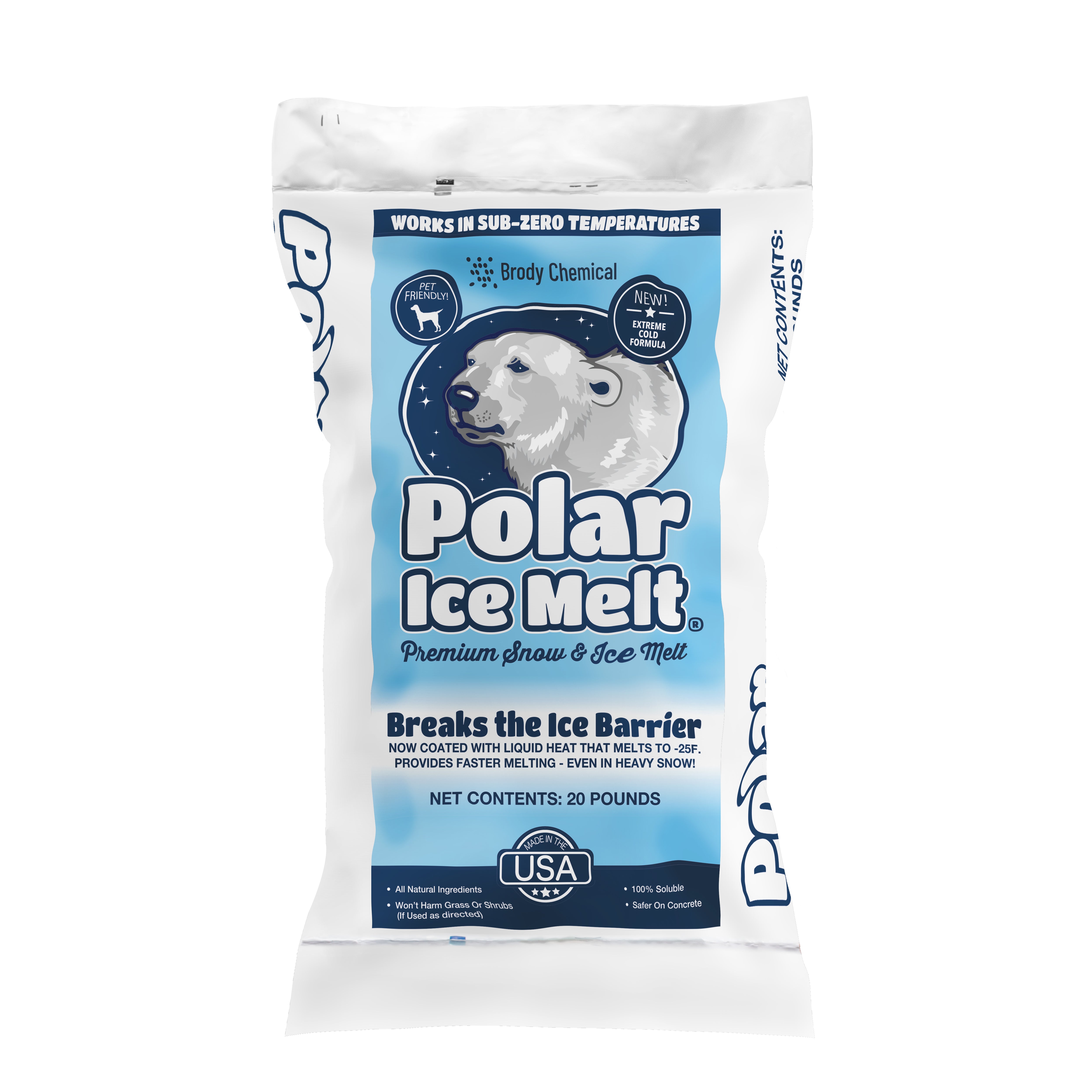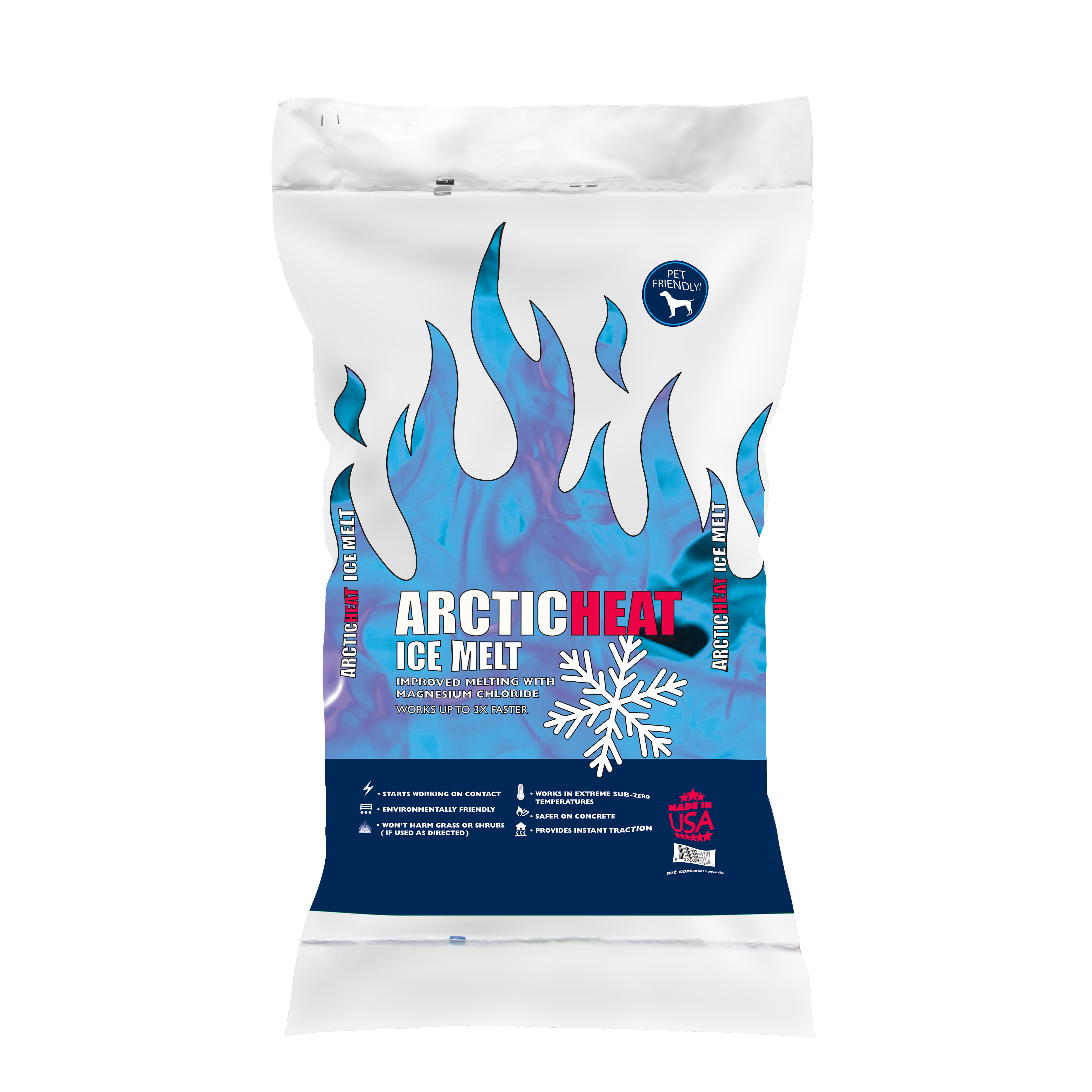Key Takeaways
- Sodium chloride (rock salt) offers the cheapest solution but quits working below 15°F and damages plants and concrete
- Calcium chloride melts ice fastest and handles brutal cold down to -20°F, though it costs more and can harm vegetation
- Magnesium chloride balances performance and environmental impact, staying effective to -13°F while causing less surface damage
- Liquid de-icers work immediately without waiting for granules to dissolve, making them perfect for pre-treatment strategies
Sodium Chloride: The Standard Rock Salt
Most people reach for sodium chloride first. Rock salt has dominated winter maintenance for decades because it's cheap and widely available. You'll find it stacked at hardware stores from October through March.
This workhorse product delivers solid performance when temperatures hover between 15°F and 32°F. Below that threshold, chemistry takes over and rock salt becomes about as useful as gravel. The melting action slows considerably, then stops completely.
Performance Characteristics
Rock salt needs moisture to start working. The granules dissolve slowly, forming a brine that interrupts ice crystal formation. Traffic helps by crushing crystals and spreading the solution across pavement. On quiet side streets or parking lots, you'll wait longer for results.
Timing matters with rock salt. Apply it too early when snow's still falling, and you waste product. Wait until ice forms thick, and you'll struggle to get penetration. Hitting that sweet spot—when snow stops but before ice hardens—gives you the best return.
Where Rock Salt Falls Short
Concrete and metal pay the price for rock salt's effectiveness. The chloride ions attack rebar in concrete and corrode vehicle undercarriages. Landscaping near treated sections suffers too. Plants absorb salt-laden runoff, leading to browning and die-off by spring.
Pets hate rock salt for good reason. The crystals irritate paws, causing dogs to limp and lick obsessively. If ingested, sodium chloride triggers vomiting and worse. Anyone with animals should think twice before spreading standard rock salt near walking paths.
Your drainage patterns determine how much damage you'll see. Properties that funnel runoff into garden beds or natural locations will notice more problems than those with storm drains capturing most meltwater.
Calcium Chloride: The Cold-Weather Champion
When arctic air settles in for days, calcium chloride earns its keep. This aggressive de-icer generates heat through an exothermic reaction, actually warming up as it dissolves. That built-in advantage lets calcium chloride tackle ice that laughs at rock salt.
Operating temperatures down to -20°F make this product indispensable for regions that see extended sub-zero stretches. Alaska, northern Minnesota, and high-altitude Colorado rely on calcium chloride when nothing else functions.
Speed and Effectiveness
Watch calcium chloride work and you'll see the difference immediately. Ice starts melting within minutes rather than the slow crawl of rock salt. For emergencies—think icy steps before morning commutes—this speed advantage becomes critical.
The heat generation means calcium chloride penetrates thick ice layers that other products merely scratch. You'll use less product overall because each application works harder. Property managers dealing with heavy foot traffic appreciate the quick clearance calcium chloride provides.
Drawbacks Worth Considering
Higher costs sting at checkout. Calcium chloride typically runs two to three times the price of rock salt. Budget-conscious buyers need to weigh that expense against superior performance and reduced application rates.
This product attracts moisture aggressively, which creates its own headaches. Track it indoors, and you're dealing with slippery residue on floors. The same property that makes calcium chloride effective in cold weather turns it into a cleaning problem later.
Vegetation damage remains a concern, though less severe than with rock salt. The bigger risk comes from over-application. A little calcium chloride goes far, so heavy-handed spreading wastes money and increases environmental impact.

Magnesium Chloride: The Balanced Alternative
Magnesium chloride balances cost and performance, working down to -13°F while treating surfaces more gently than other options. Commercial properties favor this product for reliable cold-weather results without aggressive surface damage.
Surface-Friendly Chemistry
Concrete lasts longer with magnesium chloride—causing 75% less pavement damage than rock salt. New installations and parking garages benefit most from this gentler approach.
Metal surfaces corrode slower too. Maintenance crews specify magnesium chloride around sensitive equipment because it reduces the attack rate on vehicles and infrastructure.
Plants tolerate this product better than other chloride salts. The reduced toxicity means less spring cleanup and healthier landscaping, though direct garden bed contact should still be avoided.
Application Considerations
Pricing falls between rock salt and calcium chloride. Melting speed sits in the middle too—slower than calcium chloride but faster than rock salt.
Storage demands attention. Magnesium chloride absorbs moisture from air, so keep bags sealed in dry locations to prevent clumping.
Liquid De-icers: Pre-Treatment Power
Liquid ice melter attacks ice immediately without waiting for granules to dissolve. Pre-treating surfaces before storms creates a barrier that prevents ice from bonding to pavement, reducing scraping needs.
Advantages of Liquid Solutions
Sprayers deliver consistent coverage, eliminating bare spots and over-salted patches. You control exactly where product goes, reducing waste.
Quality liquid products work past -15°F—matching solid calcium chloride performance without the cleanup issues. Lower application rates mean better cost efficiency per treated section.
Practical Limitations
Equipment costs create barriers. Tanks, pumps, and sprayers make sense for large properties but not single driveways.
Wind wastes product through spray drift. Calm conditions work best. Traffic immediately after application spreads liquid before it bonds fully, so pre-treatment beats reactive application.
Recommendation:
Facing winter's chill? Brody Chemical Snow & Ice Melt products are designed to tackle icy conditions effectively. Whether you're dealing with sidewalks, driveways, or commercial spaces, our solutions ensure safety and reliability.
Explore Now →
Specialty Products: Pet-Safe and Eco-Friendly Options
Eco melt and similar formulations use acetate-based or organic chemistry to minimize harm while melting ice. Premium pricing buys peace of mind around gardens, pets, and water sources.
Acetate-Based Formulas
Calcium magnesium acetate (CMA) biodegrades rather than persists in soil. Airports use CMA to protect planes and ecosystems.
CMA works down to 20°F—covering mild to moderate conditions but failing in severe cold. Pets walk on treated surfaces without paw irritation, and plants tolerate acetate products far better than chloride salts.
Urea-Based Products
Urea is pet-safe but functions poorly below 25°F. The nitrogen content acts as fertilizer, causing algae blooms in waterways and excessive lawn growth. Property owners must weigh direct toxicity concerns against downstream nutrient loading problems.
Choosing the Right Product for Your Needs
Climate determines product selection. Southern properties with occasional freezes below 25°F can use standard rock salt. Northern regions with sub-zero weeks need calcium chloride or advanced blends.
Temperature-Based Selection
Standard rock salt works for climates near freezing (20-32°F). Magnesium chloride handles regular teen temperatures (10-20°F). Calcium chloride or polar ice melt covers brutal cold below 10°F.
Surface and Environmental Factors
New concrete needs gentler treatment. Sub-zero snow and ice melt or magnesium chloride preserves pavement.
Properties with landscaping should avoid rock salt. Pet owners need pet-safe formulations for high-traffic zones.
Application Best Practices Across Product Types
Getting the most from any ice melt means knowing proper application. More product doesn't equal better results—it equals wasted money and increased environmental damage.
Timing Strategies
Pre-treating beats reactive scrambling every time. Liquid applications before storms prevent ice bonding. Granular products work better applied to light snow that provides moisture for dissolving.
Early morning applications catch whatever warmth daylight provides. Pavement temperature matters more than air temperature, so sunny winter days offer a performance boost even when ambient temperatures stay low.
Avoid applying during active snowfall with rock salt or magnesium chloride. You'll bury the product under accumulation before it can work. Wait for snowfall to taper off, then apply to the thin remaining layer.
Coverage Rates
Follow manufacturer guidance on application rates. Heavier doesn't mean faster melting—it means wasted product sitting on already-clear pavement.
High-traffic zones need lighter applications because vehicle tires spread and activate the product. Parking lots and driveways clear with less ice melt than walkways seeing only foot traffic.
An ice melt comparison across different products shows calcium chloride requires roughly one-third the amount of rock salt for equivalent results. Factor this into cost calculations rather than just comparing bag prices.
Storage and Handling Considerations
Proper storage extends product life and maintains effectiveness. Most ice melts absorb moisture from air, turning into rock-hard clumps that won't spread properly.
Best Storage Practices
Keep all products in sealed containers or bags inside dry structures. Garages work better than outdoor sheds where humidity fluctuates. Elevated pallets prevent ground moisture from wicking into bags.
Calcium and magnesium chlorides demand extra care due to their hygroscopic nature. These products pull water from air aggressively, so any breach in packaging leads to rapid deterioration.
Buy what you'll use in a season. Products stored over summer suffer more degradation than fresh stock purchased each fall. Price breaks on bulk purchases seem attractive until you factor in waste from spoiled product.
Safety Handling
All chloride-based ice melts irritate skin and eyes. Wear gloves when spreading, and wash hands after application. Kids and pets should stay clear of freshly applied product until it fully dissolves.
Track-in problems plague all ice melt products to varying degrees. Place mats inside entries and sweep away visible residue daily during active winter periods. Spring will require thorough cleaning to remove remaining deposits.
Performance Optimization Through Blended Strategies
Smart property owners combine different types of ice melt rather than relying on a single product. This approach matches each situation with the best tool while controlling costs.
Pre-treat with liquid products before storms, then follow up with granular calcium chloride for quick spot treatment of problem zones. Reserve bulk rock salt for low-priority sections where some ice persistence is tolerable.
The best types of ice melt for your property might include three or four different products working together. Main entrances get premium treatment with fast-acting options. Secondary walkways get standard rock salt. Gardens near treated locations receive only the gentlest formulations.
Check out our complete snow and ice melt collection to find the right combination for your needs.
 Building Your Winter De-icing Strategy
Building Your Winter De-icing Strategy
The right de-icing strategy isn't about finding one perfect product—it's about building a toolkit that adapts to whatever winter throws at you. Stock your property with options that match your typical conditions, then keep a premium backup for those brutal cold snaps that catch everyone off guard.
FAQ
What type of ice melt works fastest on thick ice?
Calcium chloride generates heat while dissolving, making it the fastest option for thick ice layers. Expect visible melting within 5-10 minutes versus 20-30 minutes for rock salt.
Can I mix different types of ice melt products together?
Mixing products generally works fine and can balance cost with performance. Many commercial blends combine calcium chloride with rock salt. Avoid mixing urea-based products with chloride salts, as this dilutes the effectiveness without a clear benefit.
How much ice melt do I actually need per square foot?
Most products require 2-4 ounces per square yard for light ice, doubling for heavy accumulation. Over-application wastes money and increases surface damage without improving melting.
Does ice melt expire or lose effectiveness over time?
Ice melt doesn't technically expire, but storage conditions affect performance significantly. Properly stored in sealed containers in dry locations, most ice melts maintain effectiveness for 2-3 years.



